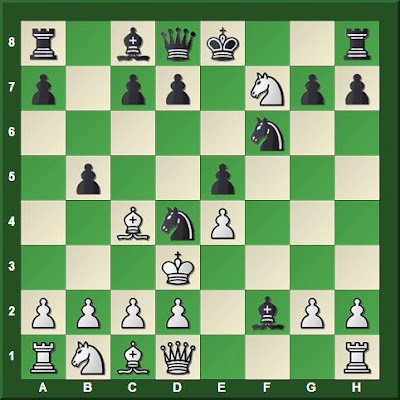Lesson of the Week
My advanced students spent half an hour on the game that gave the Traxler Counter-Attack its name.
Reinisch,J -- Traxler,Karel [C57]
Hrána vs. Hostoun, Hostoun, 20.03.1890
1.e4 e5 2.Nf3 Nc6 3.Bc4 Nf6 4.Ng5 Bc5
4...d5 is the most common move here, leading either to the Fried Liver Attack or a variation, considered safer for Black, that has several names for different White approaches. These were mentioned briefly.
Someone entered notes by Karel Traxler in this game on chessgames.com. Traxler wrote concerning 4...Bc5, which he appears to have been the first to play, "An original combination that is better than it looks. A small mistake by white can give black a decisive attack. It is not easy to find the best defense against it." His entire notes to the game, published in Zláta Praha (14 October 1892), are available online at Digitalizovaný Archiv Časopisů.
White to move
This position is exercise 9 in my Knight Award Problems (see the complete set at "Knight Award Problems"). I use this position to encourage students to chose a few opening tableaus that they study with the intention of being better prepared than their opponents. It is a position that is often reached in youth chess tournaments.
5.Nxf7!?
5.Bxf7 Ke7 and then either 6.Bd5 or 6.Bb3 leaves White a pawn ahead and thus an advantage.
5...Bxf2+ 6.Ke2
Two other lines must be explored as well, if the student is to be well prepared to play 5.Nxf7.
a) 6.Kf1 seems best.
b) 6.Kxf2 invites 6...Nxe4 7.Kg1 is best, and there are very good drawing chances after 7...Qh4 8.g3 Nxg3 9.hxg3 Qxg3+ 10.Kf1 Rf8.
In line b, 7.Ke2 leads to 7...Nd4+ and Black seems to be winning.
7.Ke3 is playable, but risky. A game in our school club a few years ago continued 7...Qh4 8.Nxh8?? (the decisive error) 8...Qf4+ 9.Kd3 Nb4+ 10.Ke2 Qf2#.
6...Nd4+
Students suggested 7.Kxf2! Nxe4+ 8.Kg1 and it is not clear that Black's attack will prove decisive. Meanwhile, both sides have problems.
7.Kd3 b5!
White to move
Already, White's position is very difficult.
8.Bb3
Traxler planned to meet 8.Nxd8 with 8...bxc4+ 9.Kxc4 Ba6+ 10.Kb4 and Black's attack is worth more than the sacrificed queen.
Of course, after 8.Bxb5, Black has 8...Kxf7.
8...Nxe4 9.Nxd8
9.Kxe4 is no good. 9...d5+ 10.Kd3 Bf5+ 11.Kc3 Ne2+ 12.Qxe2 Bd4+ 13.Kb4 a5+ and checkmate next move.
Black to move
Black now has a forced checkmate in nine.
9...Nc5+ 10.Kc3 Ne2+ 11.Qxe2
11.Kb4 leads to checkmate one move faster.
Bd4+ 12.Kb4 a5+ 13.Kxb5 Ba6+ 14.Kxa5 Bd3+
14...Bxe2+ does not lead to a faster win. Traxler chose the poetic option.
15.Kb4 Na6+ 16.Ka4
16.Ka3 Bc5+ 17.Ka4 Nb4#.
16...Nb4+ 17.Kxb4 c5# 0–1
Checkmate
White has all of his pieces, having given up only two pawns in the battle. But, chess is about the king, not material superiority.
My beginning students completed the worksheets, Essential Tactics 5 and 6. Here are two of the exercises.
White to move
White to move
All of the exercises from these worksheets, as well as the solutions are now available in a Kindle book: Essential Tactics: Building a Foundation for Chess Skill (2017).




















No comments:
Post a Comment